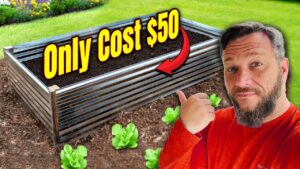Building a metal raised garden bed can be a rewarding project, offering numerous benefits such as improved drainage, easier weed control, and a more accessible gardening experience. This guide will walk you through the process step-by-step, from planning and gathering materials to constructing and filling your raised garden bed.
Benefits of a Metal Raised Garden Bed
- Durability: Metal garden beds are long-lasting and resistant to weather conditions, pests, and rot.
- Aesthetic Appeal: Metal beds can add a modern and sleek look to your garden.
- Improved Soil Drainage: Elevated beds provide better drainage, reducing the risk of waterlogged roots.
- Ease of Access: Raised beds are easier to maintain and harvest, especially for those with mobility issues.
Materials Needed
- Metal Sheets: Galvanized steel or corrugated metal are common choices.
- Corner Braces: To secure the corners of the bed.
- Bolts, Nuts, and Washers: For assembling the metal sheets and braces.
- Protective Gear: Gloves, safety glasses, and hearing protection.
- Tools: Measuring tape, marker, drill, metal cutting saw, wrench set, and a level.
Planning and Design
- Determine the Size and Location:
- Size: Decide on the dimensions of your garden bed. Common sizes are 4×8 feet, which allows easy access from all sides.
- Location: Choose a sunny spot with good drainage. Ensure the location is easily accessible for watering and maintenance.
- Design Considerations:
- Height: Typical heights range from 12 to 24 inches. Taller beds reduce bending and are easier on the back.
- Shape: Rectangular beds are the most common, but you can customize the shape to fit your garden layout.
Step-by-Step Construction

Step 1: Gather and Prepare Materials
- Purchase Metal Sheets: Ensure the sheets are pre-cut to the desired length or have them cut at the store.
- Corner Braces and Fasteners: Gather enough corner braces and fasteners for the number of beds you plan to build.
- Protective Gear: Wear gloves and safety glasses to protect yourself from sharp edges and metal shards.
Step 2: Prepare the Site
- Clear the Area: Remove grass, weeds, and debris from the site.
- Level the Ground: Use a shovel and a rake to create a flat, even surface. A level ensures stability and prevents soil erosion.
Step 3: Assemble the Metal Sheets
- Lay Out the Sheets: Arrange the metal sheets on the ground in the shape of your garden bed.
- Drill Holes: Mark and drill holes at the corners where the sheets will be joined. Ensure the holes are evenly spaced for a secure fit.
- Attach Corner Braces: Position the corner braces on the inside of the bed and align them with the drilled holes.
- Secure with Bolts: Insert bolts through the holes and secure them with nuts and washers. Use a wrench to tighten them, ensuring the bed is stable and secure.
Step 4: Reinforce the Structure
- Add Additional Braces: For longer beds, add additional braces along the sides to prevent bowing and maintain structural integrity.
- Check for Stability: Ensure all bolts are tight and the bed is stable. Adjust as necessary.
Step 5: Prepare the Bed for Planting
- Line the Bottom (Optional): Line the bottom with landscape fabric or hardware cloth to prevent weeds and pests from entering the bed.
- Fill with Soil: Fill the bed with a high-quality garden soil mix. A good mix includes compost, topsoil, and organic matter for nutrients and drainage.
- Water Thoroughly: Water the soil thoroughly before planting to settle it and eliminate air pockets.
Planting and Maintenance
- Select Plants: Choose plants suitable for your climate and the bed’s location. Consider companion planting to maximize space and improve yield.
- Planting: Follow planting guidelines for spacing and depth. Water the plants well after planting.
- Mulch: Apply a layer of mulch to retain moisture and suppress weeds.
- Regular Maintenance: Water regularly, especially during dry periods. Monitor for pests and diseases, and apply organic treatments as needed.
- Seasonal Care: At the end of the growing season, remove dead plants and debris. Amend the soil with compost to replenish nutrients.
Tips for Success
- Start Small: If you’re new to gardening, start with one or two small beds to get the hang of it.
- Use Quality Materials: Investing in good-quality metal and hardware will ensure your bed lasts for many years.
- Plan for Irrigation: Consider installing a drip irrigation system for efficient watering.
- Rotate Crops: Rotate crops each season to prevent soil depletion and reduce the risk of pests and diseases.
Conclusion
Building a metal raised garden bed is a fantastic way to enhance your gardening experience. With careful planning, quality materials, and proper maintenance, your metal raised garden bed will provide a beautiful and productive growing space for years to come. Whether you’re a seasoned gardener or a beginner, the benefits of a raised bed are well worth the effort. Happy gardening!